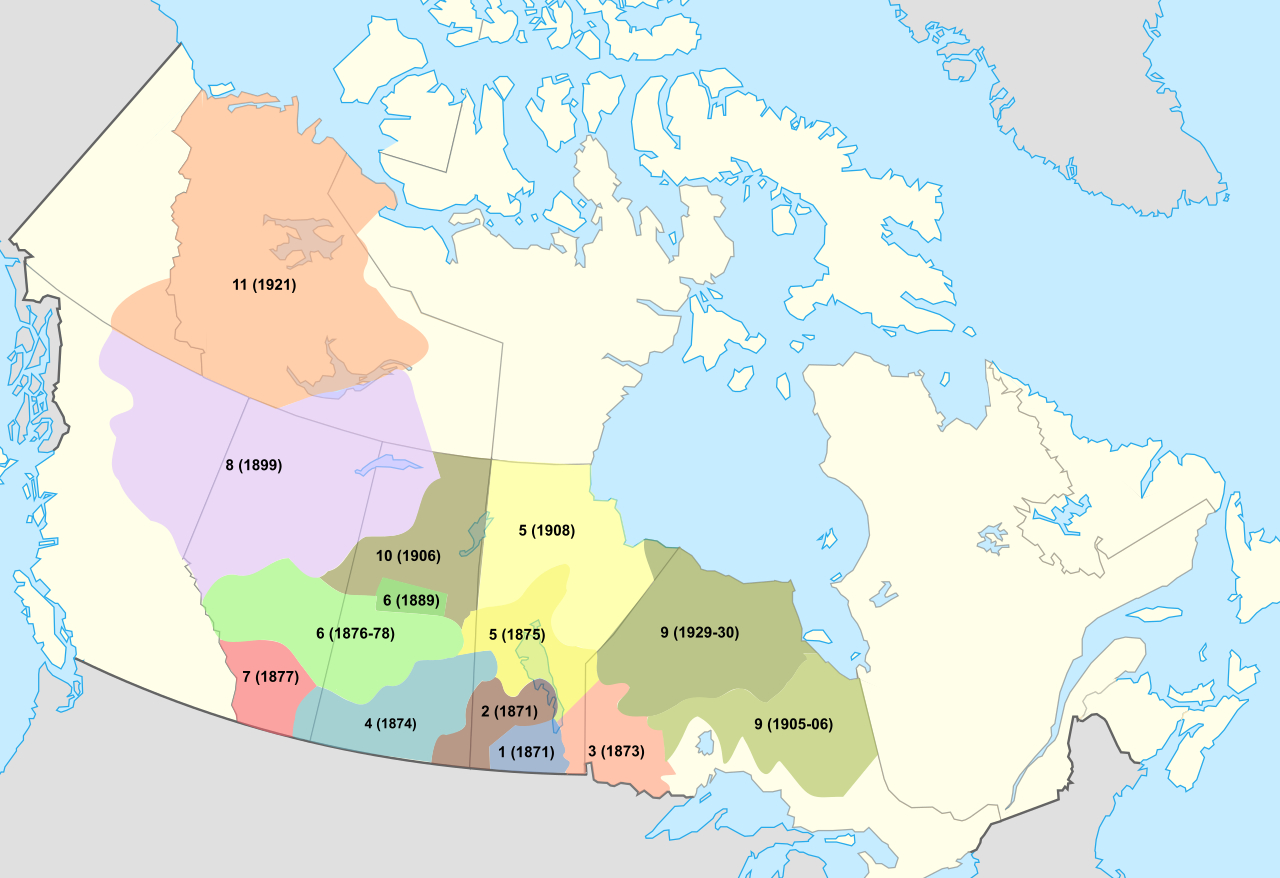History
2 The Numbered Treaties
Learning Objectives
- Consider why the Government of Canada set out to negotiate the Numbered Treaties.
- Analyze the effects of the Numbered Treaties on Aboriginal Title in British Columbia.
The first order of business for the Canadian government was twofold: secure land for settlement and the construction of the Canadian Pacific Railway to unite the provinces. The Royal Proclamation made it illegal for individuals or businesses to make agreements with Indigenous communities, and the land was explicitly reserved for all Indigenous Peoples. To do this, the government had to purchase lands and so engaged in the process of negotiating the “Numbered Treaties” (Black, 2014).

The Numbered Treaties remain controversial to this day. The Government of Canada views them as treaties for the legal purchase of land, with modest “reserves” set aside for Indigenous groups (Filice, 2016). Affected groups viewed the treaties as a “right-of-way” or a sharing agreement, or did not understand the language that would have made clear the intent of the Canadian government. Further, some chiefs felt they had no choice but to sign due to diminishing local resources and the rapidly changing ability of communities to be self-sustaining. Lastly, some of the signers may not have had authority to sign the treaties — a recurring theme that will come up again later on when discussing the Crown’s “duty to consult.”
The North-West Resistance of 1885 in Saskatchewan and Alberta, led by Louis Riel, was in part a response to the Numbered Treaties. Food was becoming scarce on the previously abundant prairies, and the development on involuntarily surrendered land left the Métis and Plains peoples (Cree, Siksika, Kainai, Piikani, and Saulteaux) in a difficult position. Louis Riel formed a provisional government, which lasted only a few short months before the rebellion was quashed by the Canadian government.
In British Columbia, there is a notable and important absence of Numbered Treaties across most of the province. The rationale for why the federal government did not pursue these treaties more aggressively in British Columbia is unclear. The provincial government website notes, “When British Columbia joined Canada in 1871, the Province did not recognize Indigenous title so there was no need for treaties” (Province of British Columbia, n.d.-b).[1] However, Guuduniia LaBoucan, writing for Canada’s History magazine, notes that the governor of the colony of British Columbia, James Douglas, attempted to negotiate treaties in 1864 (LaBoucan, 2018). This was categorically rejected by the colonial secretary, who wrote that the British taxpayer would not burden themselves with that purely colonial expense. It appears that the governor, not wishing to impede the movement of settlers into B.C., then simply issued proclamations that the Crown owned all land in B.C. — despite the clear language of the Royal Proclamation.[2] This is further complicated by the fact that Treaty 8, which includes Northeastern B.C., was signed in 1899 to offer gold miners more certainty to their legal claims. Under the government’s premise that B.C. lawfully owned all land in the province, this would have been an entirely unnecessary negotiation.
Regardless of the rationale, the impact of not having any of the Numbered Treaties in British Columbia cannot be overstated. The land was never lawfully ceded as was required under the Royal Proclamation, 1763. Canada’s Constitution Act, 1982, reaffirms the rights of Aboriginal peoples — rights that were never extinguished in most of British Columbia.
Image Descriptions
A map of Canada showing the lands covered by each of the eleven Numbered Treaties that were established between 1871 and 1921. It includes most of northern and western Ontario, all of Manitoba, Saskatchewan, and Alberta, northeastern British Columbia, most of Northwest Territories, southeastern Yukon, and a small bit of northwestern Nunavut. [Return to Numbered Treaties Map]
Image Attributions
- “Numbered Treaties Map” by Themightyquill is licensed under a CC BY-SA 2.5 Licence. Adapted from Canada Location Map by Yug, which is licensed under a CC BY-SA 2.5 Licence.
- See also Indigenous and Northern Affairs Canada, 2010. ↵
- Douglas had also negotiated treaties on Vancouver Island before becoming governor of British Columbia (see Douglas Treaties). These are similar in nature to the Numbered Treaties, but as they were not negotiated by the Government of Canada, they are not considered part of that series of treaties. ↵

